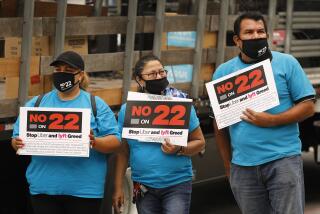Affirmative action and the law
As the Supreme Court mulls whether the U.S. Constitution prohibits state universities from taking race into account in admissions decisions, a federal appeals court has moved in a very different direction. It recently held that, far from forbidding affirmative action, the Constitution prevents a state’s voters from doing away with it.
The case, decided this month by the U.S. 6th Circuit Court of Appeals, was filed after Michigan voters approved Proposal 2, barring state and local governments as well as public universities from giving preferential treatment on the basis of race, sex, color, ethnicity or national origin. That proposal had been championed by Ward Connerly, the former University of California regent who had helped persuade voters here to approve a similar measure, Proposition 209, in 1996.
In theory, we would be pleased to see the end of affirmative action bans such as Proposition 209 and Proposal 2. This page strongly opposed Proposition 209 when it was on the ballot. We continue to believe that affirmative action is a reasonable, fair and effective way to redress past harms and promote diversity at public universities. We hope that the Supreme Court, which is currently hearing a different case involving affirmative action, reaffirms its constitutionality.
But though we support affirmative action, we also believe that voters have a right to ban it. And while we looked with favor on a constitutional challenge to Proposition 209 in the late 1990s, we do not agree with the 6th Circuit’s decision. It’s ingenious, but ultimately mistaken.
The decision is rooted in the 14th Amendment’s guarantee of “equal protection of the laws.” But Judge Guy Cole Jr.’s majority opinion focused not on the fairness (or unfairness) of racial preferences in admissions, but rather on the fact that the Michigan ballot initiative “reorders the political process in Michigan to place special burdens on minority interests.” As a result, he said, minorities who would benefit from affirmative action were deprived of “equal access to the tools of political change.”
He offered this illustration:
“A student seeking to have her family’s alumni connections considered in her application to one of Michigan’s esteemed public universities could do one of four things to have the school adopt a legacy-conscious admissions policy: she could lobby the admissions committee, she could petition the leadership of the university, she could seek to influence the school’s governing board, or, as a measure of last resort, she could initiate a statewide campaign to alter the state’s constitution. The same cannot be said for a black student seeking the adoption of a constitutionally permissible race-conscious admissions policy. That student could do only one thing to effect change: she could attempt to amend the Michigan Constitution — a lengthy, expensive, and arduous process — to repeal the consequences of Proposal 2.”
Cole cited two Supreme Court decisions for his conclusion that equal protection of the laws is a guarantee that “minority groups may meaningfully participate in the process of creating … laws and the majority may not manipulate the channels of change so as to place unique burdens on issues of importance to them.” In 1969, the high court overturned a city charter amendment in Akron, Ohio, that required that any ordinance prohibiting housing discrimination be approved in a citywide referendum. In 1982, it struck down an initiative approved by voters in Washington state that barred school districts from busing children to distant schools for the purpose of racial integration.
But in a dissenting opinion, Judge Julia Smith Gibbons effectively distinguished those cases from the Michigan affirmative action measure. For example, she noted that the charter amendment that was overturned in Akron had made it difficult to enact laws guaranteeing “equal treatment” in housing, not preferential treatment. A similar point was made by the U.S. 9th Circuit Court of Appeals 15 years ago in rejecting a constitutional challenge to Proposition 209 — a ruling that was recently reaffirmed. That court wrote: “It is one thing to say that individuals have equal protection rights against political obstructions to equal treatment; it is quite another to say that individuals have equal protection rights against political obstructions to preferential treatment.”
That holding, which the conservative majority on the Supreme Court is likely to prefer to the 6th Circuit’s reading of the Constitution, makes legal sense. But it also places the debate about the wisdom of racial preferences in public education where it belongs: in the political sphere. Instead of asking courts to roll back unfavorable referendums, advocates of affirmative action in Michigan, California and elsewhere need to make their case to the public the way Ward Connerly and his allies made theirs. When they do, they’ll have our support.
More to Read
A cure for the common opinion
Get thought-provoking perspectives with our weekly newsletter.
You may occasionally receive promotional content from the Los Angeles Times.










